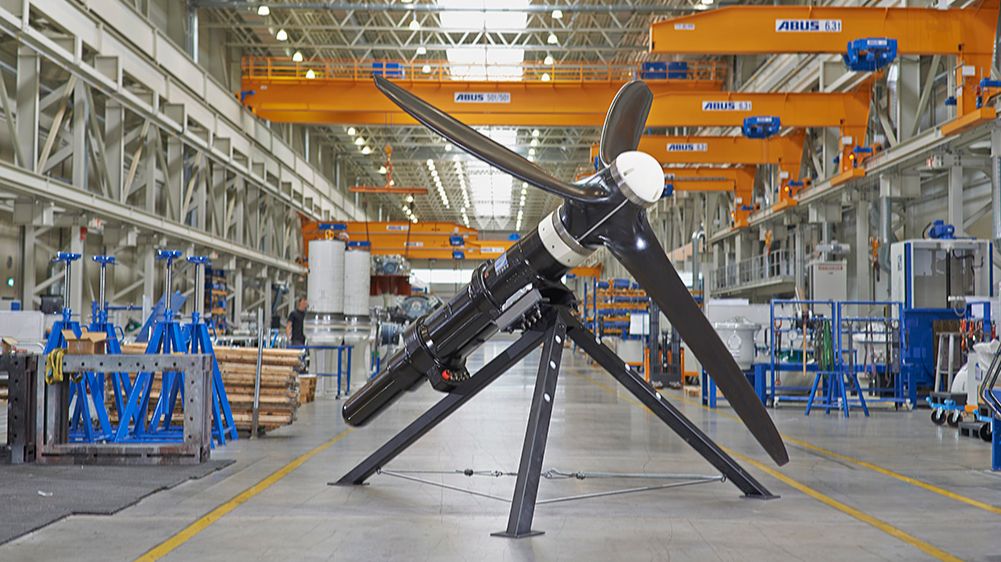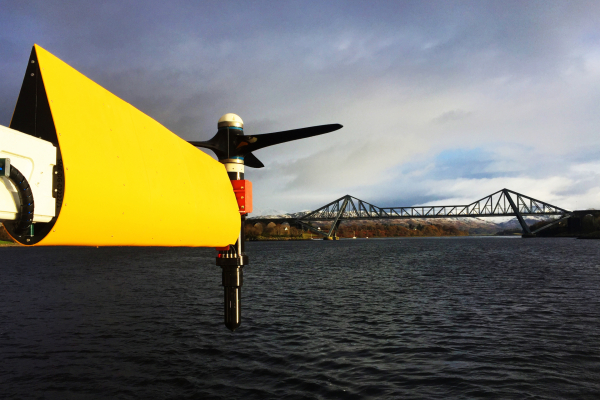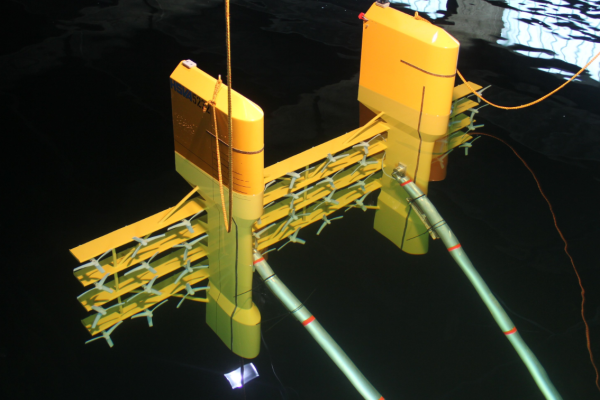 © SHY
© SHY
Hydropower and Marine Energy
Ocean currents – an energy source for the future
The oceans' tidal currents provide an inexhaustible source of energy that has hardly been used so far. Compared with solar and wind power, it has an invaluable advantage: it is a reliable energy supplier. The high and low tides change continuously and predictably. Under certain topographical conditions, this ocean current can be used to generate energy. The Tidal Power research project aims to develop a semi-submersible floating system and a modular turbine system. The turbine technology is already on the verge of market maturity and is currently being further tested in the field.
Project context
Tides refer to the oceans' water movements. These are caused by the moon’s gravitation. The currents change in accordance with the moon’s position relative to the earth and lead to high and low tides and, depending on the nature of the coast, to a tidal range between just a few metres to 15 metres in Brittany, France. Individual power plants have been previously constructed that utilise this tidal range with a dam and conventional turbines to generate electricity. However, there are only a few bays and estuaries in the world where there is a sufficient tidal range. In addition, the dam usually has a serious impact on the environment. These power plants account for only a small proportion of electricity production.
In accordance with the principle used by wind turbines, turbines with free flow around them can use sufficiently strong water currents to generate electricity. A dam is not required. Owing to the higher density of water for a given flow velocity, the output of a water current is about 1,000 times higher than that of an air flow. That is why fairly gently flowing tidal currents are sufficient for producing electricity. So far, however, this has remained a distant dream. No commercial power plant is yet in operation owing to the high investment costs.
Research focus
The experts in the Tidal Power research project (development of a platform system for the cost-efficient use of tidal energy) are working on an innovative marine energy system. The aim is to significantly reduce both the maintenance and investment costs. In contrast to most research efforts, the Tidal Power research teams are not relying on a turbine firmly anchored to the seabed in the megawatt range, but on a floating platform, the TRITON platform. This platform is anchored to the seabed via a swivel joint and can align itself automatically to the tidal current. A modular turbine system with up to 40 small turbines is attached to the floating structure between two vertically protruding hulls.
The turbines can be accessed for maintenance at any time and can be brought to the surface with the platform. This requires that the ballast tanks are emptied. In addition to simpler logistics, this approach also offers a better performance/cost ratio and redundancy in the event of a fault. Each individual turbine can be operated independently. The associated power electronics are housed in the floats and thus allow easy access for maintenance purposes.
Innovation
In addition to the platform's design principle, the system integration is also particularly innovative. 40 turbine systems are integrated on a single platform. The research teams focussed on aspects relating to the loads on the TRITON platform caused by various operating conditions, the operational management, floating behaviour as well as the installation and anchoring. The experts compared simulations and model tests of the platform system with one another and enabled a reliable prediction of the behaviour of rigs with the planned full-scale design. The results enabled them to plan the platform system in detail.
The work focussed on developing the modular turbine system and a simple and lightweight drive train design, the interaction of the turbine grid as well as the design of the rotor blade geometry. The research teams have taken the different rotor design requirements into account through multidimensional optimisation. This considered various boundary conditions such as the rotor efficiency, load and cavitation use. The resulting outcomes were validated by model tests and measurements on the large rig in the field.
Results
The research team developed a floating platform and successfully tested the model. The work included the detailed design, calculations, operational management and a detailed cost report. The resulting total costs for a single demonstration rig are significantly higher than the costs estimated at the start of the project. In particular, higher demands were placed on the rig’s anchoring to the seabed, the steel structure and the logistical work required for on-site installation. The teams tested the developed turbine system directly in field trials in Scotland and were thus able to test the new methods, for example with model test technology using measurement data from the field. Overall, the project partners made considerable progress in regulating the turbines and rotors as well as in further developing the drive train. The results support the desired commercialisation of the turbine system.
Practical transfer
The tidal energy market has changed in the course of the project and it has been necessary to adapt the project to these developments. At the beginning of the research work, the focus was on solutions in the large power plant sector, for example for markets in Canada, the UK and France subsidised by feed-in tariffs. At present, the potential market is mainly with smaller, off-grid standalone solutions for replacing diesel generators (for example for islands in Southeast Asia). The feed-in tariff in Canada is still in place. Experts therefore assume that the first commercial demonstrations of turbine technology will take place in Canada. Similar to the beginnings of wind power, the expansion will take place in stages and the associated costs for the technology will likewise be reduced.
The turbine technology is on the verge of market maturity and is currently being further tested in the field. The platform developed as part of the project will not be commercially usable in the near future. The project teams plan to replace it with a smaller platform floating on the surface. The first field tests are currently being carried out. The participating institutions are planning a first commercial demonstrator with 3 platforms and a total installed capacity of 1.26 MW for 2020.









